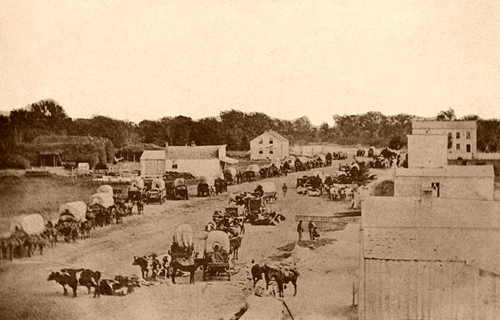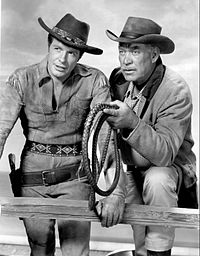Facts About the Conestoga Wagon
(Covered Wagon)
As pioneers ventured out into the unknown territories of the West to settle, families packed their tools and belongings in covered wagons that were built for the long haul. FactFrenzy.com presents these facts about the early invention which made it possible.
Covered wagons were the primary means of transporting freight and pioneer families for more than 100 years. The Conestoga Wagon was first built in Conestoga, PA around 1750.
6 or 8 oxen or horses were used to pull the Conestoga wagons.
The Conestoga wagon and its animals would measure as far as 60 feet long.
The cover on the wagon was made of a white canvas material which was stretched over bows. The canvas cover protected the rider and contents from storms and heat, and provided privacy.
The bows that provided the frame under the canvas were made of wood. There were usually 8 to 12 on each Conestoga covered wagon to support the cover.
Conestoga wagon wheels would be built up to 6 feet high. The height of the axles was intended to clear ruts in the roads and tree stumps.
The wheels had 10 inch broad oak rims, to help prevent the covered wagon from sinking in the mud. Conestoga wagon wheels were painted red.
The entire wagon stood up to 11 feet high, and was up to 24 feet long, from the front and rear canvas tips.
On the back of the Conestoga covered wagon, a feed box was mounted for the animals.
On the side of the Conestoga covered wagon a tool chest was mounted. Next to it, a water barrel was also mounted which was especially needed in long trips crossing the plains.
The “lazy board” was the projecting oak board on the Conestoga wagon. This is where the driver would sit or stand to guide the animals, rest, or operate the brake.
The “tongue” was the arm that protruded from the front of the Conestoga wagon to the animals that pulled the wagon. They were about one horse’s length.
The body of the Conestoga wagon was painted blue and red. The sides were built very deep to protect against arrows and bullets during an attack.
The body of the wagon was built with pitch and/or tar in between the board seams. This prevented leaks, which made it possible for the Conestoga wagon to cross rivers.
The front and back ends of the Conestoga covered wagon were slanted to keep the contents (and people) from spilling out while traveling on steeper hills.
Conestoga covered wagons were said to look like “boats” as they crossed the prairies. This is because the slanted ends gave the body a boat-like appearance. Additionally, the grasses of the praries would often be as high as the wheels. Therefore, from a distance, the Conestoga wagon would have the illusion of a boat gliding across the “water” as it moved smoothly above the tall grass.



Interesting post!
ReplyDeleteGlad you enjoyed it, Gorges. Amazing what those pioneers accomplished!
DeleteDid you notice one of the pictures was from Sturgis?
ReplyDeleteAnother one reminded me of the Basque sheep wagons. See http://idahosheepcamp.com/the_basque for some history and lots of pictures.
If you want one better order now, $500 price increase in December. Be sure to look at the pictures of the inside.
Terry
Fla.
You have a keener eye than I do! Interesting link/pics - don't have a horse so I would have to pull it behind my Jeepster!
Delete